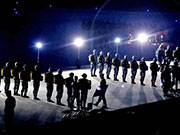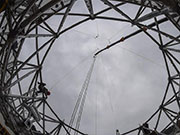


The brilliant flash of an exploding star's shockwave -- what astronomers call the "shock breakout" -- is illustrated in this photo. (NASA)
WASHINGTON, March 21 -- Scientists using the U.S. Kepler space telescope said Monday they have captured for the first time the brilliant flash of an exploding star's shockwave, called a "shock breakout," in the visible light range.
The researchers, led by Peter Garnavich, an astrophysics professor at the University of Notre Dame, Indiana, analyzed light captured by Kepler every 30 minutes over a three-year period from some 50 trillion stars.
They were hunting for signs of massive stellar death explosions known as supernovae, which begin when the internal furnace of a star runs out of nuclear fuel causing its core to collapse as gravity takes over.
During an supernovae, a supersonic shockwave is sent out from the star's core, which will then cause a bright flash of light, called a "shock breakout," when it reaches the surface of the star.
"The flash from a breakout should last about an hour, so you have to be very lucky or continuously stare at millions of stars just to catch one flash," said Garnavich.
In the study, the researchers discovered two supernovae in the act of exploding, which were captured by Kepler in 2011.
The first, KSN 2011a, is nearly 300 times the size of Sun and a mere 700 million light years from Earth. The second, KSN 2011d, is roughly 500 times the size of Sun and around 1.2 billion light years away.
While both explosions delivered a similar energetic punch, no shock breakout was seen in KSN 2011a, the smaller of the two stars.
The researchers said that is likely due to the smaller one being surrounded by gas, perhaps enough to mask the shockwave when it reached the star's surface.
The findings will be published by the Astrophysical Journal.
Day|Week

 96-Year-Old Veteran Becomes Fashion Icon
96-Year-Old Veteran Becomes Fashion Icon Creative mother produces 232 unique breakfasts
Creative mother produces 232 unique breakfasts Charming folk customs in Kalajun Grassland
Charming folk customs in Kalajun Grassland A glimpse of ships and boats commissioned to PLA Navy in past 3 years
A glimpse of ships and boats commissioned to PLA Navy in past 3 years Chongqing sniper’s new record: 13 holes on a rice grain
Chongqing sniper’s new record: 13 holes on a rice grain Women put on spring dresses in Hangzhou
Women put on spring dresses in Hangzhou UAVs at Unmanned Systems Exhibition & Conference in UAE
UAVs at Unmanned Systems Exhibition & Conference in UAE PLA's paratroopers conduct night training
PLA's paratroopers conduct night training Three new-type tank landing ships join the East China Sea Fleet
Three new-type tank landing ships join the East China Sea Fleet 3,492 reflector panels of China's mega telescope installed
3,492 reflector panels of China's mega telescope installed